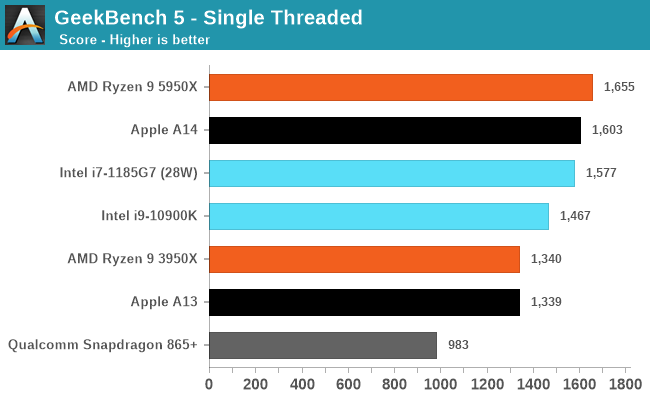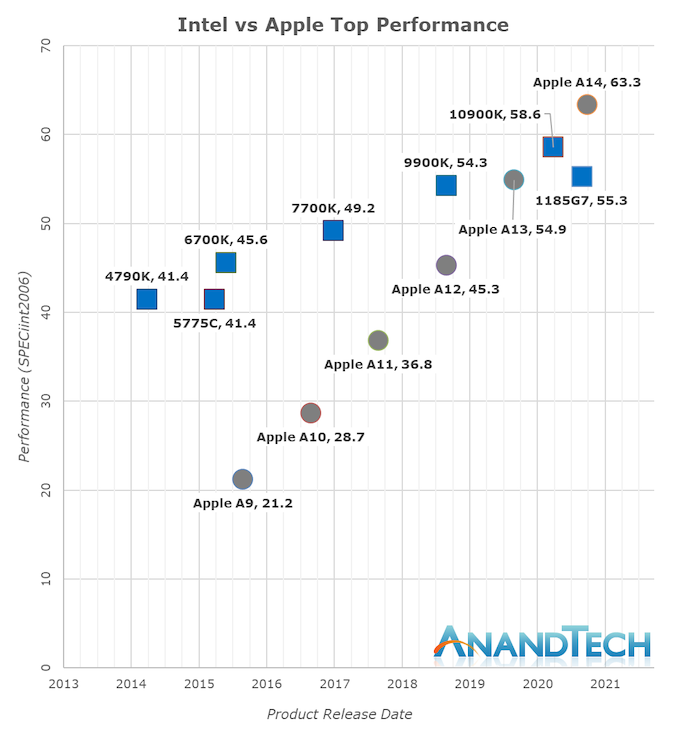Apple Announces The Apple Silicon M1: Ditching x86 - What to Expect, Based on A14
by Andrei Frumusanu on November 10, 2020 3:00 PM EST- Posted in
- Apple
- Apple A14
- Apple Silicon
- Apple M1
From Mobile to Mac: What to Expect?
To date, our performance comparisons for Apple’s chipsets have always been in the context of iPhone reviews, with the juxtaposition to x86 designs being a rather small footnote within the context of the articles. Today’s Apple Silicon launch event completely changes the narrative of what we portray in terms of performance, setting aside the typical apples vs oranges comparisons people usually argument with.
We currently do not have Apple Silicon devices and likely won’t get our hands on them for another few weeks, but we do have the A14, and expect the new Mac chips to be strongly based on the microarchitecture we’re seeing employed in the iPhone designs. Of course, we’re still comparing a phone chip versus a high-end laptop and even a high-end desktop chip, but given the performance numbers, that’s also exactly the point we’re trying to make here, setting the stage as the bare minimum of what Apple could achieve with their new Apple Silicon Mac chips.

The performance numbers of the A14 on this chart is relatively mind-boggling. If I were to release this data with the label of the A14 hidden, one would guess that the data-points came from some other x86 SKU from either AMD or Intel. The fact that the A14 currently competes with the very best top-performance designs that the x86 vendors have on the market today is just an astonishing feat.
Looking into the detailed scores, what again amazes me is the fact that the A14 not only keeps up, but actually beats both these competitors in memory-latency sensitive workloads such as 429.mcf and 471.omnetpp, even though they either have the same memory (i7-1185G7 with LPDDR4X-4266), or desktop-grade memory (5950X with DDR-3200).
Again, disregard the 456.hmmer score advantage of the A14, that’s majorly due to compiler discrepancies, subtract 33% for a more apt comparison figure.

Even in SPECfp which is even more dominated by memory heavy workloads, the A14 not only keeps up, but generally beats the Intel CPU design more often than not. AMD also wouldn’t be looking good if not for the recently released Zen3 design.

In the overall SPEC2006 chart, the A14 is performing absolutely fantastic, taking the lead in absolute performance only falling short of AMD’s recent Ryzen 5000 series.
The fact that Apple is able to achieve this in a total device power consumption of 5W including the SoC, DRAM, and regulators, versus +21W (1185G7) and 49W (5950X) package power figures, without DRAM or regulation, is absolutely mind-blowing.

There’s been a lot of criticism about more common benchmark suites such as GeekBench, but frankly I've found these concerns or arguments to be quite unfounded. The only factual differences between workloads in SPEC and workloads in GB5 is that the latter has less outlier tests which are memory-heavy, meaning it’s more of a CPU benchmark whereas SPEC has more tendency towards CPU+DRAM.
The fact that Apple does well in both workloads is evidence that they have an extremely well-balanced microarchitecture, and that Apple Silicon will be able to scale up to “desktop workloads” in terms of performance without much issue.
Where the Performance Trajectory Finally Intersects
During the release of the A7, people were pretty dismissive of the fact that Apple had called their microarchitecture a desktop-class design. People were also very dismissive of us calling the A11 and A12 reaching near desktop level performance figures a few years back, and today marks an important moment in time for the industry as Apple’s A14 now clearly is able to showcase performance that’s beyond the best that Intel can offer. It’s been a performance trajectory that’s been steadily executing and progressing for years:
Whilst in the past 5 years Intel has managed to increase their best single-thread performance by about 28%, Apple has managed to improve their designs by 198%, or 2.98x (let’s call it 3x) the performance of the Apple A9 of late 2015.
Apple’s performance trajectory and unquestioned execution over these years is what has made Apple Silicon a reality today. Anybody looking at the absurdness of that graph will realise that there simply was no other choice but for Apple to ditch Intel and x86 in favour of their own in-house microarchitecture – staying par for the course would have meant stagnation and worse consumer products.
Today’s announcements only covered Apple’s laptop-class Apple Silicon, whilst we don’t know the details at time of writing as to what Apple will be presenting, Apple’s enormous power efficiency advantage means that the new chip will be able to offer either vastly increased battery life, and/or, vastly increased performance, compared to the current Intel MacBook line-up.
Apple has claimed that they will completely transition their whole consumer line-up to Apple Silicon within two years, which is an indicator that we’ll be seeing a high-TDP many-core design to power a future Mac Pro. If the company is able to continue on their current performance trajectory, it will look extremely impressive.











644 Comments
View All Comments
grayson_carr - Wednesday, November 11, 2020 - link
The article explains that a wider CPU design would be much more difficult for x86. You should probably read it.vais - Thursday, November 12, 2020 - link
Wider instruction decoder doesn't always mean better. And remember you are comparing two entirely different instruction sets. As mentioned in the article x86 has variable length instructions, so one instruction can be decoded into multiple micro operations.Anyway, take a look at this quote from the article specifically:
"On the ARM side of things, Samsung’s designs had been 6-wide from the M3 onwards, whilst Arm’s own Cortex cores had been steadily going wider with each generation, currently 4-wide in currently available silicon"
So Samsung's core is 6 wide, while Cortex are 4 wide. Isn't snapdragon using Cortex cores, assuming "only" 4 wide - how the hell it outperforms the "superior" architecture?
Apple's A14 is 30-40% faster than Exynos and Snapdragon (let's say). And how do Exynos and Snapdragon compare to desktop x86 CPUs? They are lightyears behind and this is normal.
rtharston - Thursday, November 12, 2020 - link
Hear hear. Armv8 (ARM64) is a newer, cleaner ISA, with different design decisions, including purposefully breaking compatibility with ARM32 in many ways* (hence why iOS and macOS dropped 32 bit app support a while back), which means Apple has an easier time making some things bigger, because they are simpler than in x86.*Yes, you can run ARM32 bit apps on ARM64 chips, if they've included the necessary support, but it is separate hardware and commands. Apple decided to rip out that extra hardware a few generations of A chips back, freeing up space and complexity for other things. x86 hardware still supports running code meant for the 8086 which released nearly 40 years ago, and that adds a lot of complexity.
misan - Thursday, November 12, 2020 - link
I really don't know what more evidence you need. You have been shown various common CPU algorithms running with comparable performance on Apple's phone chip and AMD/Intel desktop chips. It's literally there in the article you are commenting. If you don't find this evidence convincing, how can you be sure that Zen 3 is a fast CPU? That statements based on exactly the same kind of evidence.vais - Friday, November 13, 2020 - link
@misan - the problem is this "evidence" is circumstantial at best and does not reflect actual performance for a normally running A14 vs a normally running (all cores and at full power) AMD 5950X.It does show the architecture is good, but the claims about a 5W chip somehow slamming in the ground a 105W, 16 core Zen3 CPU are nothing but hilarious. Otherwise Crysis would have long been ported for the magically powerful iPhone...
Spunjji - Thursday, November 12, 2020 - link
@Coldfriction - You seem to be getting confused. Custom silicon does indeed punch above its weight, but none of the "small scale tests" done in this article will take advantage of any of it.SPEC results don't translate readily to application performance, but they do serve as excellent ways to compare CPU architectures; whichever way you slice it this architecture is demonstrably impressive.
Mgradon - Thursday, November 12, 2020 - link
Agree fully - for MacBook Air it might be the right think to do. If the new OS will work well. For MacBook Pro i am not sure, would like to see what it can and what it cannot do.daveedvdv - Thursday, November 12, 2020 - link
> No doubt what they have is efficient. But their claims are out of this world high. If it was simply a matter of making a wider CPU design, AMD or Intel would have done exactly that years ago. If it were simply a matter of making a larger L2 cache, AMD or Intel would have done that years ago.Of course. So that's not what dominates Apple's lead. For example, a significant part of Apple's advantage is power management: PA Semi had critical patents in that area and I believe they're still in effect.
techconc - Wednesday, November 11, 2020 - link
"...there's essentially no way that Apple made a general computing CPU that is faster than Intel or AMD..."That's exactly what they've done. They've also done so with a far more power efficient solution. It's funny how people can deny reality even while seeing the results in articles like this. Take the blinders off and see reality.
Coldfriction - Wednesday, November 11, 2020 - link
What results? The benchmarks here are extremely limited in scope. That's not "generic computing".